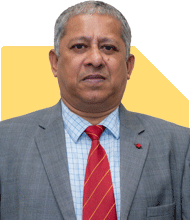43-Year-Old with 35L Investments and 40L in FDs - Can I Retire Comfortably in 10 Years?
Ramalingam Kalirajan |8317 Answers |Ask -Follow
Mutual Funds, Financial Planning Expert - Answered on Dec 27, 2024
He has an MBA in finance from the University of Madras and is a certified financial planner.
He is the director and chief financial planner at Holistic Investment, a Chennai-based firm that offers financial planning and wealth management advice.... more

Hello Experts, I am 43 old having a monthly Sal of 2.6L/Month wife Sal is 40K/Month. We have 35L invested in MF and Equity ( Stocks) we have have close to 40L in FD and Post office, as part of retirement my PF is close to 40L we have 2 kids 11 and 7 years old. We have a 3BHK flat, we have no loans. health insurance of 10L for family and 15L for my mother who is 72 years old. Doing a SIP of 1.5L per month, we started investing 2 years back, along with SIP we did some lumpsum investments also. Is it possible to have a good corpus in next 10 years.
Income and Expenses
Your combined family income is Rs. 3,00,000 per month.
With no loans, you have a healthy cash flow for investments.
Existing Investments
Rs. 35 lakh is invested in mutual funds and equity stocks.
Rs. 40 lakh is in fixed deposits and post office schemes.
Your retirement corpus in PF is Rs. 40 lakh.
Insurance Coverage
Health insurance of Rs. 10 lakh covers your family.
Separate Rs. 15 lakh health insurance covers your mother.
Current SIP and Lump Sum Investments
Your SIP contribution of Rs. 1.5 lakh per month is substantial.
Investments started two years ago, showing focused financial planning.
Retirement Planning
You aim to accumulate a good corpus in 10 years.
Your PF of Rs. 40 lakh will continue to grow over time.
Focus on equity for wealth creation due to long-term growth potential.
Assessing Your Goals
Consider retirement and children’s education as key goals.
Plan for higher education expenses when kids are 18–20 years old.
Ensure funds for post-retirement lifestyle and medical needs.
Suggested Investment Strategy
Continue with your SIP of Rs. 1.5 lakh per month.
Allocate 60–70% of your SIP to equity mutual funds for growth.
Invest in flexi-cap, large-cap, and mid-cap funds for balanced risk.
Allocate 20–30% to debt funds for stability and lower risk.
Emergency Fund and Contingency Planning
Maintain an emergency fund of at least 12 months of expenses.
Use liquid funds or short-term FDs for this purpose.
Diversification of Investments
Limit exposure to fixed deposits due to lower returns.
Gradually move some FD funds to mutual funds for higher growth.
Keep post office investments for secure, low-risk returns.
Tax Efficiency of Investments
Understand new capital gains taxation on equity and debt mutual funds.
Plan redemptions to optimise long-term and short-term capital gains taxes.
Fixed deposit interest is taxable. Diversify to reduce tax burden.
Education Planning
Start a dedicated corpus for children’s higher education.
Invest separately for this goal in equity mutual funds.
Use child-specific funds or regular funds through a Certified Financial Planner.
Risk Management
Review health insurance to ensure coverage is adequate.
Consider increasing family health coverage to Rs. 20 lakh if feasible.
Buy a term insurance policy for 15–20 times your annual income.
Reviewing and Rebalancing
Review your portfolio every year with a Certified Financial Planner.
Check fund performance and rebalance based on market conditions.
Avoid emotional decisions during market volatility.
Avoid Common Pitfalls
Avoid direct mutual fund investments without expert guidance.
Use regular funds to benefit from professional advice and support.
Refrain from mixing insurance and investment products.
Final Insights
Your financial planning is on the right track. Continue disciplined investments and strategic diversification. Focus on long-term growth through equity and maintain safety through debt. Regular reviews and a Certified Financial Planner’s guidance can ensure your goals are met comfortably.
Best Regards,
K. Ramalingam, MBA, CFP,
Chief Financial Planner,
www.holisticinvestment.in
https://www.youtube.com/@HolisticInvestment
You may like to see similar questions and answers below
Ramalingam Kalirajan |8317 Answers |Ask -Follow
Mutual Funds, Financial Planning Expert - Answered on May 15, 2024
Ramalingam Kalirajan |8317 Answers |Ask -Follow
Mutual Funds, Financial Planning Expert - Answered on Jul 16, 2024
Ramalingam Kalirajan |8317 Answers |Ask -Follow
Mutual Funds, Financial Planning Expert - Answered on Dec 13, 2024
Dr Dipankar Dutta |1196 Answers |Ask -Follow
Tech Careers and Skill Development Expert - Answered on May 05, 2025
Prof Suvasish Mukhopadhyay |608 Answers |Ask -Follow
Career Counsellor - Answered on May 05, 2025
Dr Nagarajan Jsk |365 Answers |Ask -Follow
NEET, Medical, Pharmacy Careers - Answered on May 05, 2025
Milind Vadjikar |1206 Answers |Ask -Follow
Insurance, Stocks, MF, PF Expert - Answered on May 04, 2025
Radheshyam Zanwar |1593 Answers |Ask -Follow
MHT-CET, IIT-JEE, NEET-UG Expert - Answered on May 04, 2025
Vipul Bhavsar |68 Answers |Ask -Follow
Tax Expert - Answered on May 04, 2025
Vipul Bhavsar |68 Answers |Ask -Follow
Tax Expert - Answered on May 04, 2025
Vipul Bhavsar |68 Answers |Ask -Follow
Tax Expert - Answered on May 04, 2025
Radheshyam Zanwar |1593 Answers |Ask -Follow
MHT-CET, IIT-JEE, NEET-UG Expert - Answered on May 04, 2025
Dr Nagarajan Jsk |365 Answers |Ask -Follow
NEET, Medical, Pharmacy Careers - Answered on May 04, 2025

Best wishes.
POOCHO. LIFE CHANGE KARO.
























